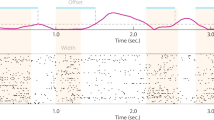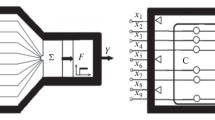Summary
In the central nervous system information transmission and processing are accomplished by pulses and pulse trains. The superposition of pulse trains is essential for information processing as it allows the execution of several logical operations, e.g. the multiplication of afferent signals.
Jenik (1961) has pointed out that for the superposition of periodic pulse trains the rate of coincidence is proportional to the product of the pulse repetition frequencies (“multiplication law“). Furtheron he has shown that this simple principle is not always applicable. Errors may occur for certain repetition frequencies of the pulse trains. If the product of signals is accomplished by superposition, mechanisms must exist reducing these errors. Since pulse trains in the nervous system always vary stochastically the following paper is concerned with the effect of random pulse trains in superposition. Two different types of random pulse trains are investigated, trains with random phase and trains with random interval between the pulses. For these two cases calculation methods are given. It is also shown that the deviations from the “multiplication law” may disappear when superimposing random pulse trains.
Similar content being viewed by others
Literatur
Becker, D.: Statistisch schwankende Impulsfolgen und ihre Überlagerung. Kybernetik-Tagg Kiel 1965. Im Druck.
Feller, W.: An introduction to probability theory and its applications, 2. ed. New York: John Wiley & Sons 1957.
Huggins, W.: Signal flow graphs and random signals. Proc. I.R.E. 45, 74–86 (1957).
Jenik, P.: Die Überlagerung von Impulsfolgen in Systemen mit einer Schwelle. Dissertation am Institut für Allgemeine Nachrichtentechnik der TH Darmstadt 1961; - Kurzfassung der Dissertation. A.B.Ü. 16, 173–188 (1962).
Krickeberg, K.: Wahrscheinlichkeitstheorie. Stuttgart: J. B. Teubner 1963.
Küpfmüller, K.: Die nachrichtenverarbeitenden Funktionen der Nervenzellen. In: Aufnahme und Verarbeitung von Nachrichten durch Organismen, Hrsg. Nachrichtentechnische Gesellschaft im VDE, S. 17–27. Stuttgart: Hirzel 1961.
Küpfmüller, K., u. F. Jenik: Über die Nachrichtenverarbeitung in der Nervenzelle. Kybernetik 1, l-6 (1961).
Lee, Y. W.: Statistical theory of communication. New York: John Wiley & Sons 1960.
Author information
Authors and Affiliations
Additional information
Meinem verehrten Lehrer, Herrn Professor Dr.-Ing. E.h. K. Küpfmuller, danke ich herzlich für sein ständiges Interesse an meiner Arbeit und für viele anregende Diskussionen.
Auszug aus einer von der Fakultät für Elektrotechnik der Technischen Hochschule Darmstadt genehmigten Dissertation.
Rights and permissions
About this article
Cite this article
Becker, D. Zur Berechnung statistisch schwankender Impulsfolgen und ihrer Überlagerung. Kybernetik 3, 191–196 (1966). https://doi.org/10.1007/BF00290256
Received:
Published:
Issue Date:
DOI: https://doi.org/10.1007/BF00290256




